ALP 4.7% vs GRN
Incumbent MP
Jennifer Kanis, since 2012.
Geography
Central suburbs of Melbourne. The electorate of Melbourne covers the Melbourne CBD and the inner-city suburbs of East Melbourne, Docklands, Carlton, Parkville, North Melbourne and Kensington. The electorate covers most of the City of Melbourne on the northern side of the Yarra River, and a small part of the City of Yarra.
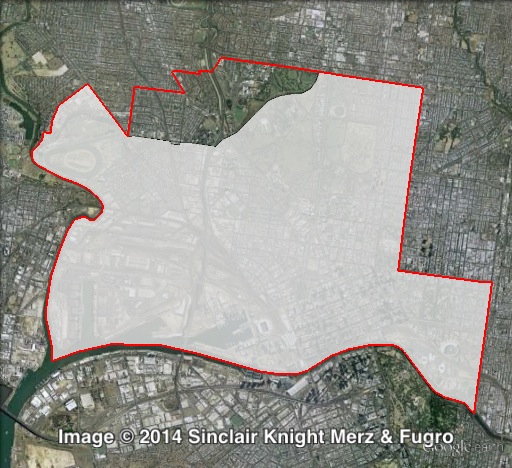
Redistribution
Melbourne lost Travancore and part of Flemington (the only part of Melbourne in the City of Moonee Valley) to Essendon, and a small area to Brunswick. It is estimated that these changes cut the Labor margin against the Greens from 6.2% to 4.7%.
History
There was a district with the name “Melbourne” in the original Victorian Legislative Assembly at the 1856 election, before being abolished in 1859. It was recreated in 1889 as a single member district that has existed ever since. The seat has a long history of being held by the ALP, who have held it continously since 1908.
The recreated Melbourne district was won by Geoffrey Carter in 1889, and was won in 1900 by Labor candidate Edward Findley. Findley was expelled in 1901 for seditious libel after publishing an Irish article criticising the King in a radical union newspaper that he edited. He lost the following by-election, but went on to serve in the Senate from 1903 to 1917 and again from 1922 to 1928.
The 1901 by-election was won by Conservative candidate James Boyd, who supported conservative state governments, including serving as a minister from 1907 to 1908, when he stepped down. He was elected as a federal Liberal MP in 1913 and served until his defeat in 1919.
Melbourne was won by Labor candidate Alexander Rogers in 1908. He held the seat until 1924. He was succeeded by Thomas Hayes, who held the seat until 1955. That year, he left the ALP and joined the new ALP (Anti-Communist), the precursor to the Democratic Labor Party, but was defeated at the 1955 election.
The seat was then held by the ALP’s Arthur Clarey from 1955 until 1972. In 1972, Melbourne was won by the ALP’s Barry Jones. He held the seat until 1977, when he resigned to run for the federal electorate of Lalor, which he held until his retirement in 1998. He served as a minister in the Hawke government and went on to serve as National President of the ALP.
The seat was then filled by Keith Remington from 1977 to 1988, and Neil Cole from 1988 to 1999.
In 1999, Melbourne was won by Bronwyn Pike. She served as a minister for the entirety of the Bracks and Brumby governments. The seat of Melbourne was considered very safe in 1999, with Pike winning 63.8% of the two-party vote. In 2002, the Greens first stood in the seat, running Dr Richard di Natale, who polled 24% of the primary vote and reducing Pike’s margin to 1.9%, which remained almost exactly the same in 2006. Di Natale went on to stand for the Senate in 2007 and was elected to the Senate at the 2010 federal election.
The Greens had come close to winning in 2002 and 2006 on the back of preferences from the Liberal Party. In 2010 the Greens stood barrister and human rights advocate Brian Walters. At the 2010 federal election, the Liberal Party continued their track record of preferencing the Greens ahead of the Labor Party in Labor-Greens inner-city marginal seats in Sydney and Melbourne, which saw Adam Bandt elected as the Greens MP for the federal seat of Melbourne.
Bandt’s election, and the ensuing hung parliament which saw the Greens in the balance of power in the Senate and Bandt sharing the balance of power in the House of Representatives, triggered a backlash in the Liberal Party. In the Victorian state election three months later, the Liberal Party reversed their position on preferencing the Greens. In the inner-city Labor-Greens marginal seats of Melbourne, Richmond, Northcote and Brunswick, the Liberal Party preferenced the ALP ahead of the Greens.
In the seat of Melbourne, Pike suffered a swing of almost 9% on primary votes, with 4.5% going to the Greens and 5.9% going to the Liberal Party. This resulted in the ALP on 35.7%, the Greens on 31.9% and the Liberal Party on 28%. Despite the swing away from the ALP and towards the Greens and the Liberal Party, the Liberal preference decision helped Pike increase her two-party margin over the Greens from 1.9% to 6.2%.
Overall, the Liberal-National coalition won a narrow victory over the ALP, with 45 seats to the Coalition and 43 seats to Labor, with no seats going to independents or minor parties. Pike has followed the trend of other senior Labor MPs John Brumby and Rob Hulls in resigning from her seat, triggering a by-election.
The 2012 by-election was won by Labor’s Jennifer Kanis in a very close result. Kanis won the seat by a 1.5% margin after preferences over Greens candidate Cathy Oke. Oke topped the poll on primary votes but Kanis benefited from stronger preference flows and won.
Candidates
- Neville Chisholm (Australian Christians)
- Kerry Sutherland (Family First)
- Ellen Sandell (Greens)
- Jennifer Kanis (Labor)
- Kate Elliott (Animal Justice)
- Ed Huntingford (Liberal)
- Tehiya Umer (Voice for the West)
Assessment
Melbourne is a marginal seat, as it has been for rather a long time.
In 2010, the Greens suffered a serious setback when the Liberal Party decided to preference Labor. The Greens primary vote shot up, and the Labor vote dropped, but overall the Labor margin increased substantially with the benefit of Liberal preferences. There is no evidence that the Liberal Party regrets its 2010 decision, or plans to change its plans in 2014.
If the Liberal Party were to preference the Greens, the party would be in a very strong position to win Melbourne. Without those preferences, it’s hard to see the Greens winning.
2012 was an ideal opportunity for the Greens to win in Melbourne, and while they increased their primary vote and narrowed the margin, they were not successful in an environment where the Liberal Party was absent.
2010 election result
| Candidate | Party | Votes | % | Swing | Redist |
| Bronwyn Pike | Labor | 13,116 | 35.67 | -8.89 | 34.27 |
| Brian Walters | Greens | 11,735 | 31.92 | +4.51 | 32.57 |
| Luke Martin | Liberal | 10,281 | 27.96 | +5.88 | 28.78 |
| Rory Killen | Sex Party | 1,061 | 2.89 | +2.89 | 2.94 |
| Peter Lazzari | Independent | 231 | 0.63 | +0.63 | 0.33 |
| John Perkins | Independent | 201 | 0.55 | +0.55 | 0.56 |
| Maxine Fensom | Independent | 142 | 0.39 | +0.39 | 0.54 |
2010 two-party-preferred result
| Candidate | Party | Votes | % | Swing | Redist |
| Bronwyn Pike | Labor | 20,653 | 56.17 | +4.17 | 54.70 |
| Brian Walters | Greens | 16,114 | 43.83 | -4.17 | 45.30 |
2012 by-election result
| Candidate | Party | Votes | % | Swing |
| Cathy Oke | Greens | 10,197 | 36.52 | +4.6 |
| Jennifer Kanis | Labor | 9,321 | 33.38 | -2.29 |
| Fiona Patten | Sex Party | 1,832 | 6.56 | +3.67 |
| Stephen Mayne | Independent | 1,325 | 4.74 | +4.74 |
| David Nolte | Independent | 1,302 | 4.66 | +4.66 |
| Berhan Ahmed | Independent | 1,127 | 4.04 | +4.04 |
| Ashley Fenn | Family First | 841 | 3.01 | +3.01 |
| Michael Murphy | Democratic Labor | 521 | 1.87 | +1.87 |
| Maria Bengtsson | Christian Democratic Party | 342 | 1.22 | +1.22 |
| Joseph Toscano | Independent | 208 | 0.74 | +0.74 |
| Kate Borland | Independent | 207 | 0.74 | +0.74 |
| Adrian Whitehead | Independent | 169 | 0.61 | +0.61 |
| Patrick O’Connor | Independent | 162 | 0.58 | +0.58 |
| David James Collyer | Independent | 160 | 0.57 | +0.57 |
| John Perkins | Independent | 145 | 0.52 | -0.03 |
| Gerrit Schorel-Hlavka | Independent | 66 | 0.24 | +0.24 |
2012 by-election two-party-preferred result
| Candidate | Party | Votes | % | Swing |
| Jennifer Kanis | Labor | 14,384 | 51.51 | -4.66 |
| Cathy Oke | Greens | 13,541 | 48.49 | +4.66 |
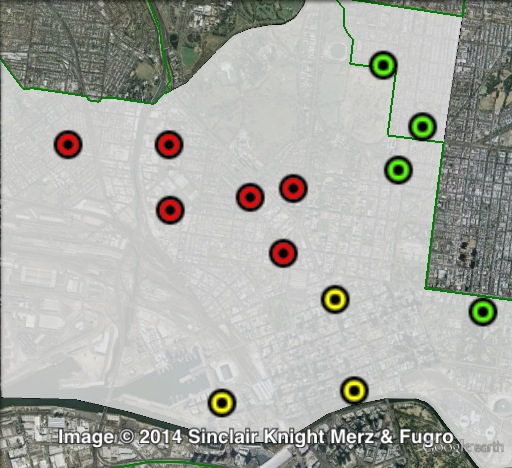
Booth breakdown
Booths in Melbourne have been divided into three parts: Central, East and South. The CBD is included in “South”.
In 2010, it is most useful to look at the primary votes for the three main parties. The ALP topped the poll in Central, with 38.9%. In East, the Greens came first, with 33.7%. Labor came second in East, and Greens came second in Central.
In the south, which includes the CBD, the Liberal Party topped the poll, followed by the Greens.
In 2012, I have examined the two-candidate-preferred vote between Labor and the Greens. Labor won the two-candidate-preferred vote in Central and the East. The Greens won a larger majority in the South, which only makes up a small part of the electorate’s population. The Sex Party polled third. Their vote was around 6-7% in Central and East, and over 11% in the South.
2010 election breakdown
| Voter group | LIB % | GRN % | ALP % | Total | % of votes |
| Central | 24.33 | 32.67 | 38.87 | 9,257 | 28.98 |
| East | 29.38 | 33.70 | 33.45 | 7,468 | 23.38 |
| South | 35.34 | 30.05 | 28.16 | 3,175 | 9.94 |
| Other votes | 30.10 | 32.47 | 32.85 | 12,048 | 37.71 |
2012 by-election breakdown
| Voter group | SEX % | GRN 2CP % | ALP 2CP % | Total | % of votes |
| Central | 6.09 | 48.80 | 51.20 | 10,821 | 38.75 |
| East | 6.77 | 48.29 | 51.71 | 6,707 | 24.02 |
| South | 11.23 | 53.16 | 46.84 | 2,913 | 10.43 |
| Other votes | 5.24 | 46.92 | 53.08 | 7,484 | 26.80 |
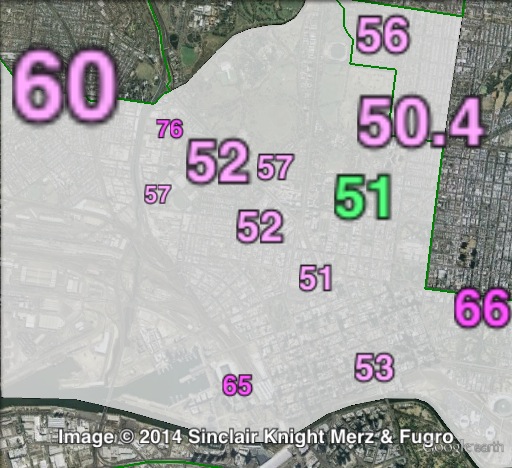
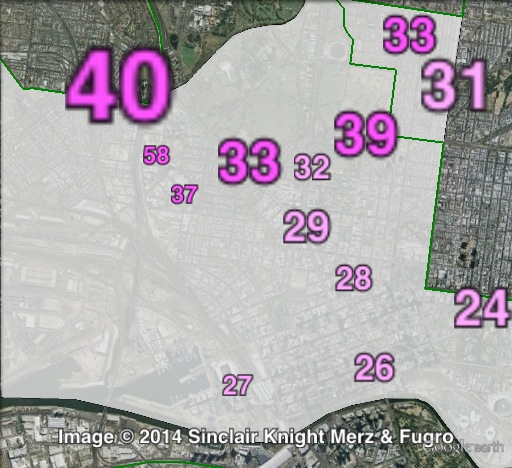
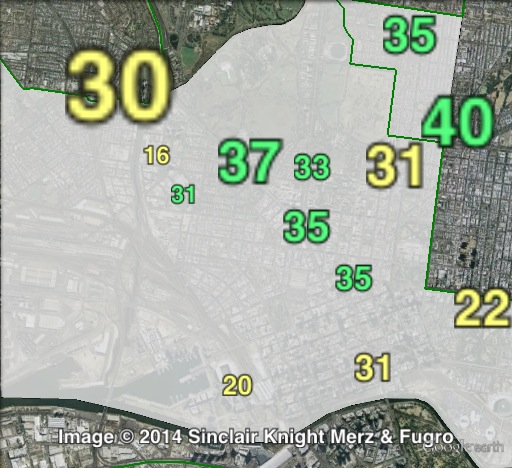
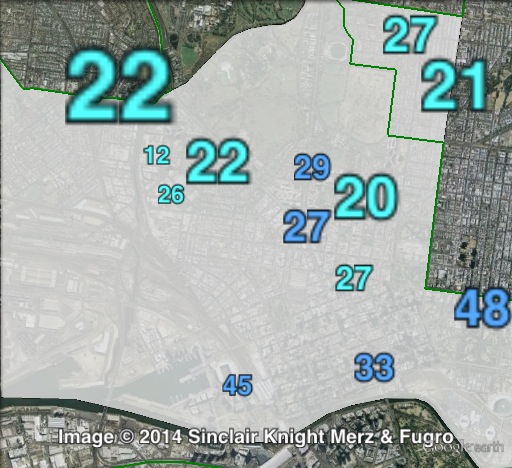
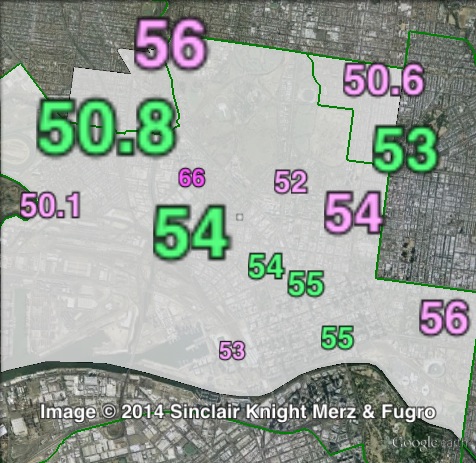


Will be interesting to see how Ellen Sandell does in this election.
It would appear that, after all the decrying of others doing preference deals, the Greens have done a deal not only with PUP but with the Libs themselves. Unbelievable hypocrisy.
http://m.theage.com.au/victoria/victoria-state-election-2014/victorian-state-election-libs-and-greens-deny-preference-deal-20141123-11s6hs.html
What evidence do you have for that claim, PJ? Because there certainly isn’t any evidence in that article.
Considering that the Greens are preferencing Labor everywhere despite not having a deal, it’s pretty outrageous of Labor to be out there trying to suggest that in fact the Greens have done the opposite, and that they have done so because of a ‘deal’ with the Liberal Party.
The ALP is trying to suggest that the timing implies some kind of deal (despite both parties saying they aren’t using the open HTVs, at least in most seats), but registration for how-to-votes is only open for one week, and they were all registered on the last day. That’s not evidence of a ‘deal’, that’s just evidence of parties rushing to get things in before the deadline.
Perhaps I misread it, but I read the article as saying that the Libs have lodged open tickets in the four seats the Greens have a shot and the Greens have lodged open tickets across the state, a position determined ‘as part of the negotiation process’. Thus, the Greens are not directing preferences to Labor and the Libs not directing preferences in the seats where their preferences will actually matter.
Or is it saying that parties lodged both open and directed tickets and get to choose what they use on the day?
Happy to be corrected, but I still think that is the meaning of the article.
Copy/paste article:
The Liberals and the Greens have denied doing a deal after both parties registered preference-free how to vote cards with the Victorian electoral commission.
Earlier this month Premier Denis Napthine said the Greens would be placed last on all Liberal how to vote tickets because the party could not be trusted on the economy or jobs.
On Saturday the Greens and Liberals registered “open tickets” which means that they do not instruct voters where to send their preferences. The parties have also registered preference tickets.
The Greens registered open tickets in all 88 lower house seats, while the Liberals lodged open tickets in four Labor-held seats vulnerable from Greens: Melbourne, Richmond, Brunswick and Northcote.
Preference flows in those seats will be crucial to the outcome in the four districts.
Greens state director Larissa Brown said the Greens would not preference the Liberals ahead of Labor in any seat. She said there was no deal and no negotiation with the Liberal party.
The Liberals on Sunday admitted the cards were created as part of the negotiation process. But Dr Napthine was adamant the Greens would remain last.
“The Liberal Party will be handing out how to vote cards that preference the Greens last. Absolutely, handing out how to vote cards, we are doing it now at the pre-polls,” Dr Napthine said.
The registered cards sent a wave of anger through the Labor party, who accused both parties of being hypocrites. Labor’s Martin Pakula said Dr Napthine’s pledge to put the Greens last was being undermined.
“It is Liberal panic versus Greens hypocrisy,” Mr Pakula said.
Northcote MP Fiona Richardson said it was head-spinning hypocrisy.
“If the Greens claim there is no deal with the Liberals and that their ticket lodgement of mutually advantageous how to vote cards is all just a coincidence, then somebody please put money on porky pigs airlines taking to the sky,” Ms Richardson said.
Ms Brown said the Greens always registered open and preference how to vote cards, with local branches then able to choose.
But she also said if there were open tickets it would be in very few seats.
“The inner city seats will not be running open tickets,” Ms Brown said
Both parties registered both HTVs that direct preferences to Labor, and HTVs that don’t direct preferences. The article is a bit confusing and implies otherwise, but that’s the journo’s fault.
It’s ridiculous that Labor feels entitled to feel “a wave of anger” that their two main political opponents (who are both actually preferencing Labor over each other) have the hide to register alternative how-to-votes that don’t even preference the other party, but simply don’t indicate preferences! And their argument seems to rely on the timing, even though the narrow window for registration means you’d expect parties to be registering on the same day.
I don’t know why the Liberal Party said what they did. Saying “part of the negotiation process” presumably means they want maximum flexibility in the last week – if you don’t register all of the options, you lose flexibility. That is not evidence of a deal with the Greens.
The Greens have used open tickets in the past. I can understand why Labor doesn’t like that, but that’s not supporting the Liberal Party, considering the vast majority of Greens voters still preference Labor in that case. Considering that Labor rejected a deal with the Greens and the Greens are still stating they are preferencing Labor in most if not all seats, I think it’s deliberately misleading for Labor to state that the Greens are working with the Liberal Party.
Fair enough. I must say I find the whole multiple registration of HTVs pretty confusing.
The Greens are campaigning very hard on Labor’s upper house preferences, ignoring that some of their own deals aren’t exactly ideologically pure, so I see Labor’s accusations as being on par with that – both fair and hypocritical at the same time.
Ben would be it be true to say that the difference in preferences flowing to the ALP between a Green HTV ticket preferencing the ALP and an open ticket would be minimal? Has anyone done an estimate as to what the difference might be?
Yes it is relatively minimal. There has been analysis but I’m not in a position to find it at the moment.
I think the registration of alternative how-to-votes can make sense in a bunch of contexts – as a threat when doing preference negotiations or a backup in case the other parties rats on their end of the deal. In this case, there has been no deal and there doesn’t seem to be a prospect of one so that seems irrelevant in this case.
I reckon the Greens just did it to create maximum flexibility, and they can’t just say “we’re not using them” because a couple of branches might be considering doing so. In my experience it’s extremely unusual that every Greens branch would make the same decision.
Doug – there was a report on that a few years back and it was pretty mininal – something like 74 per cent with an open ticket and 77 per cent with directed preferences.
Greens local groups decide preferences anyway. So regardless of every other seat in the state a local group can decide to differ.
Worst thing about that, you or I might disagree with their decision.
Best thing, you can rest assured that no one outside your area is coming in with the power to tell you what to do.